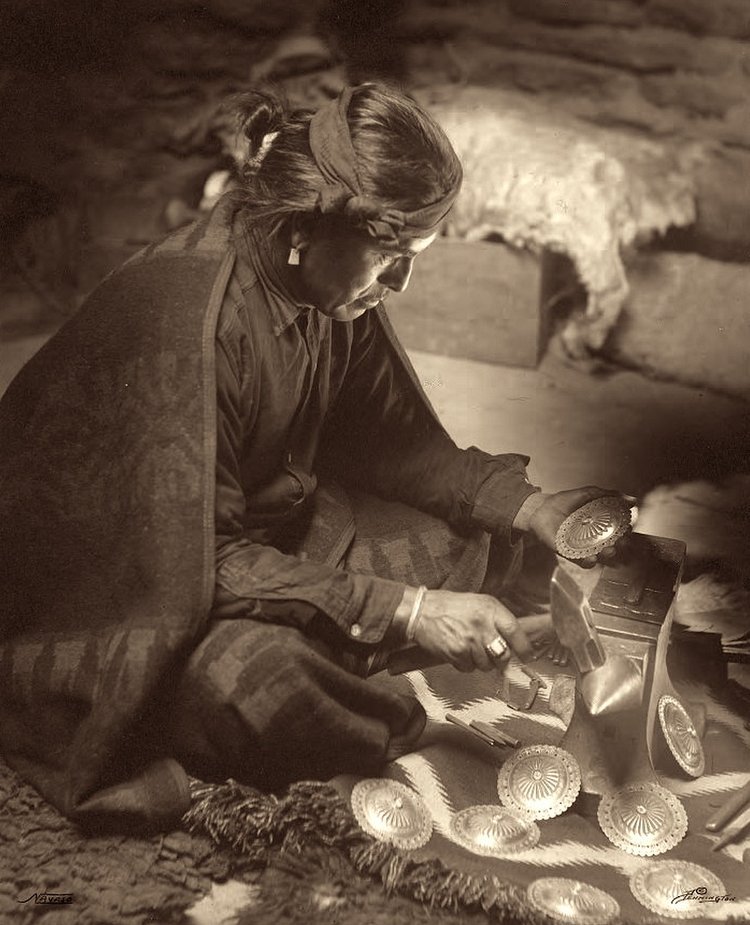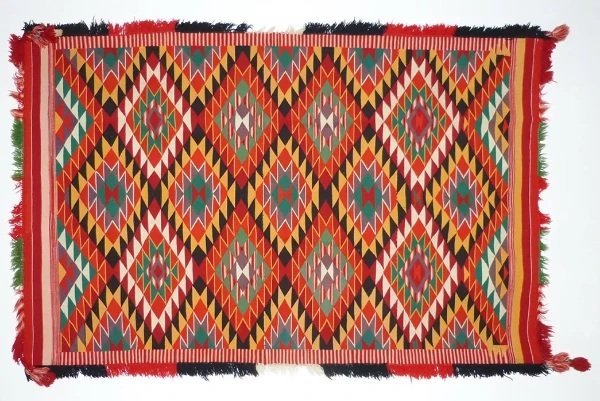Tsé Bitʼaʼí, Shiprock, San Juan County
Current Population: 399,494 (173,000 live on the reservation)
Pre-Contact Population: 16,000 - 20,000
Language: Navajo
Early Societal Structure: Seminomadic, Exogamous Matrilineal Clans, Bilateral Kinship, Matrilocal
Location: 17,568,954 acres (25,451 square miles) in Arizona, Utah, and Bernalillo, Socorro, Sandoval, Rio Arriba, McKinley, and San Juan Counties; 4,192,064 acres are located in New Mexico

Click to expand
Traditional Homelands

The Navajo Nation is the largest tribe in the United States - both in terms of land and enrolled members. Their population surpassed that of the Cherokee in 2021.
A small group of Navajos are members of the federally recognized Colorado River Indian Tribes.
The Navajo Nation headquarters is in Window Rock, Arizona on the border with New Mexico at I-40.
In 1922, the federal government organized the reservation into 110 “chapters” in order to track the Navajo population and their livestock. Chapter boundaries are arbitrary. They do not account for clans, customary land uses, or seasonal migrations. They are now “political subdivisions” that can create community land use plans but, otherwise, lack governance abilities.
The Long Walk
In the late 1700s, the Navajos were involved in direct conflict with Spanish forces who had formed alliances with the Comanches and Utes. Many Navajo fell victim to the Spanish slave trade. Kit Carson burned Navajo fields and killed their livestock, then forced them to walk to a reservation in eastern New Mexico.
More than 8,500 men, women, and children of the Ndé were forced to leave their homes in northeastern Arizona and northwestern New Mexico. In the dead of winter, they made the 300-plus-mile trek to a desolate internment camp in eastern New Mexico called the Bosque Redondo Reservation, where the military maintained the outpost, Fort Sumner. Along the way, approximately 200 Ndé died of starvation and exposure to the elements. Also, those who could not keep up with this pace (tribal elders, the sick, and pregnant women) were shot. The Dine continued to arrive at Bosque Redondo for a period of over two years.
Treaty of the Navajo
The Treaty of the Navajo ended a horrific period for the Ndé in eastern New Mexico. After the Long Walk, the U.S. attempted to assimilate the tribe and force them to go from being a semi-nomadic culture to an agrarian one. But the land of Bosque Redondo was not fertile. The site was described as one where "the Navajo had sunk into a condition of absolute poverty and despair." Their population dropped from 9,000 to 6,000.
The Treaty included provisions that would force the Ndé to stop raiding and be isolated on their land allotment, which was 13.5 million acres - a fraction of the land they used to have. The U.S. would provide seeds and tools so they could farm. The treaty established the Ndé as a sovereign nation, though made them dependent on the United States. While most of the provisions in the treaty were not honored. the Ndé have been able to grow their land and now own 16 million acres (25,000 square miles). This is the size of West Virginia and the largest reservation in the United States.
They learned horsemanship and shepherding from the Spanish. They learned agriculture after they received their land grant.
Modern Day
The Navajo Nation is a member of the Ten Tribes Partnership (along with the Jicarilla Apache), a coalition formed in 1992 to increase the involvement of tribes in the management of the Colorado River.
The Navajo Nation has struggled to maintain and modernize its water resource infrastructure. Given existing agency resources, budgets, and authorizations, many of the water infrastructure deficiencies on the reservation will continue to go unattended and the problems may become more acute.

Non-Commodity Art
A scare-eye bird repellent balloon made by Postcommodity members Raven Chacon, Cristóbal Martínez, and Kade L. Twist, 2015, Art Institute of Chicago
Founded in 2007, Postcommodity is a Native arts collective. The name refers to the "commodity era" of Native American art trading in the late 1800s and 1900s, with the "post" being in reference to their modern take on traditional Native art forms. The collective was started by Steve Yazzie (Navajo/Laguna) and Kade Twist (Cheroke) and has included innovative musician and composer, Raven Chacon (Diné.)
Born in Arizona, Raven Chacon has lived and created in New Mexico for much of his life. He earned a Bachelor of Fine Arts from the University of New Mexico and a Master of Fine Arts in music composition from the California Institute of the Arts.
Raven is a multi-media performer and artist who has worked with video, visual arts, and installations. But, perhaps he is best known for his experimentation with sound. As a solo performer, he often performed “noise music” - a style that tends to challenge the distinction that is made in conventional musical practices between musical and non-musical sound - andhas collaborated with the Santa Fe-based experiemental arts collective, High Mayhem. In 2020, as a part of Baltimore’s High Zero festival, Raven performed with Carlos Santistevan (experimental bassist and Director of High Mayhem) and Tatsuya Nakatani (internationally-famed experimental percussionist from Osaka, Japan) in Santa Fe’s San Miguel Chapel. Below is the video of the live-streamed performance - which was the first time the three artists had ever performed together. They came together once more to make a recording, released in 2022 as Inhale/Exhale.
Raven has shared his sonic explorations - both collaborative and solo - in spaces around the world, such as at international contemporary art festival in Sydney Austraila, Biennale of Sydney, the John F. Kennedy Center for the Performing Arts, at Documenta - an exhibition of contemporary art which takes place every five years in Kassel, Germany, at Adelaide International - a contemporary art festival in South Austraila, the contemporary art museum Musée d'art contemporain de Montréal, and many more.
In 2015, Raven’s room-sized sound space, Still Life #3, was exhibited in Transformer: Native Art in Light and Sound at the National Museum of the American Indian in New York City. This exhibition featured works bt ten artists who used light, digital projection, and experimental media to reflect on their place in and between traditional and dominant cultures. American Indian Magazine described Still Life #3:
“A multi-sensory exploration of belief and the understanding of the Diné creation story, this installation is rooted in our inception within a misty, undefined place followed by a journey through four distinct worlds, each defined by light and color. Retold for generations through the spoken word (although numerous anthropologists have tried to capture it in writing), the story is, at its core, one of continual movement by our Diné ancestors from one world to another. The concept of movement and story possessing a physical presence is embodied in Chacon’s use of sound. Using a row of analog speakers, he projects a female voice reciting excerpts of the Diné creation story in the Diné language. The voice palpably moves, traveling up and over the line of suspended speakers. Excerpts of the story, which alternate between Diné and English, are printed on translucent text panels that are positioned so the words appear to float through time and over the gallery walls. This visual effect is enhanced by the glowing light in the gallery, which slowly shifts through the four sacred colors – from white (dawn) to blue (midday) to yellow (dusk) to black/red (night) – casting shadows of the text onto the wall.”
Raven is the Composer-in-Residence with the Native American Composers Apprenticeship Project by the Grand Canyon Music Festival. He received a visual arts grant from the Creative Capital - a nonprofit that funds groundbreaking and innovative new works. In 2014, Raven received the Native Arts and Cultures Foundation National Artist Fellowship in Music. In 2018, he was awarded the residential fellowship the Berlin Prize by the American Academy in Berlin. And, in 2020, Raven received the Mellon Foundation Artist-in-Residence fellowship for the Colorado Springs Fine Arts Center at Colorado College.
Also in 2020, the opera Sweet Land debuted. Raven co-composed it with Chinese-born American composer, Du Yun and it was performed in Los Angeles State Historic Park. The theme for the opera: colonialism. Read the NYTimes review here.
Still Life #3, National Museum of the American Indian
Raven has taught in the music and Native American studies departments at the University of New Mexico. He has been a visiting artist in the New Media Art & Performance program at Long Island University, he is composer-in-residence for the Native American Composers Apprenticeship Project, and he is a founding member of the First Nations Composers Initiative.
As if all of that was not impressive enough, Raven’s groundbreaking music broke new ground when, in 2022, he became the first Native American to be awarded the Pulizter Prize for Music. The composition that earned him the award is called Voiceless Mass. It was written specifically for the pipe organ at the Cathedral of St. John the Evangelist in Milwaukee. He premiered the piece at the cathedral in 2021. The Pulitzer jury called Raven’s piece a "mesmerizing, original work ... that evokes the weight of history in a church setting, a concentrated and powerful music expression with a haunting, visceral impact."
Read this interview by NPR where Raven discusses the composition. (It includes a sample of the recording, too).
Or, watch this PBS video where Raven discusses his experiemntal process.
In May 2023, Raven’s work was included in the The Smithsonian American Art Museum’s media art collection and in the exhibit Musical Thinking: New Video Art and Sonic Strategies, which will be showen through January, 2024. You can download a e-book of the catalogue here.
Then, in October 2023, Raven received the MacArthur Fellowship - also known as the “Genius Grant.” As the MacArthur Foundation website says, Raven received this highly prestigeous awared because he creates “musical works that cut across boundaries of visual art and performance to illuminate landscapes, their inhabitants, and histories.”
Raven’s music and performance is really best experienced in person. New Mexican’s will soon have another chance to do that. From February 24 through July 7, 2024, the Harwood Museum of Taos will exhibit three of Raven’s projects - all of which pay tribute to indigenous women. Click here to learn more about Three Songs.













